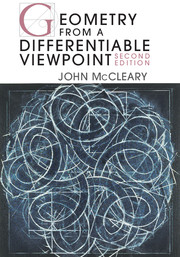Book contents
- Frontmatter
- Contents
- Preface to the second edition
- Introduction
- PART A Prelude and themes: Synthetic methods and results
- PART B Development: Differential geometry
- PART C Recapitulation and coda
- 13 Abstract surfaces
- 14 Modeling the non-Euclidean plane
- 15 Epilogue: Where from here?
- Riemann's Habilitationsvortrag: On the hypotheses which lie at the foundations of geometry
- Solutions to selected exercises
- Bibliography
- Symbol index
- Name index
- Subject index
14 - Modeling the non-Euclidean plane
Published online by Cambridge University Press: 05 November 2012
- Frontmatter
- Contents
- Preface to the second edition
- Introduction
- PART A Prelude and themes: Synthetic methods and results
- PART B Development: Differential geometry
- PART C Recapitulation and coda
- 13 Abstract surfaces
- 14 Modeling the non-Euclidean plane
- 15 Epilogue: Where from here?
- Riemann's Habilitationsvortrag: On the hypotheses which lie at the foundations of geometry
- Solutions to selected exercises
- Bibliography
- Symbol index
- Name index
- Subject index
Summary
In recent times the mathematical public has begun to occupy itself with some new concepts which seem to be destined, in the case they prevail. to profoundly change the entire order of classical geometry.
E. BELTRAMI (1868)If we adopt these definitions, the theorems of Lobachevskiĭ are true, that is to say, that all of the theorems of ordinary geometry apply to these new quantities, except those that are a consequence of the parallel postulate of Euclid.
H. POINCARÉ (1882)The notion of an abstract surface frees us to seek models of non-Euclidean geometry without the restriction of finding a subset of Euclidean space. A set, not necessarily a subset of some ℝn, with coordinate charts and a Riemannian metric determines a geometric surface. With this new freedom we achieve our goal of constructing realizations of the geometry of Lobachevskiĭ, Bolyai, and Gauss and the well-known models of non-Euclidean geometry due to E. Beltrami (1835–1906) and to Poincaré (1908).
This chapter contains many computational details like a lot of nineteenthcentury mathematics. The foundations for these calculations lie in the previous chapters. It will be the small details that open up new landscapes.
In an 1865 paper, Beltrami posed a natural geometric question: He sought local conditions on a pair of surfaces, S1 and S2, that guarantee that there is a local diffeomorphism of S1 → S2 for which the geodesics on S1 are carried to geodesics on S2. Such a mapping is called a geodesic mapping. Beltrami (1865) solved the problem when the target surface is the Euclidean plane.
Information
- Type
- Chapter
- Information
- Geometry from a Differentiable Viewpoint , pp. 251 - 281Publisher: Cambridge University PressPrint publication year: 2012
